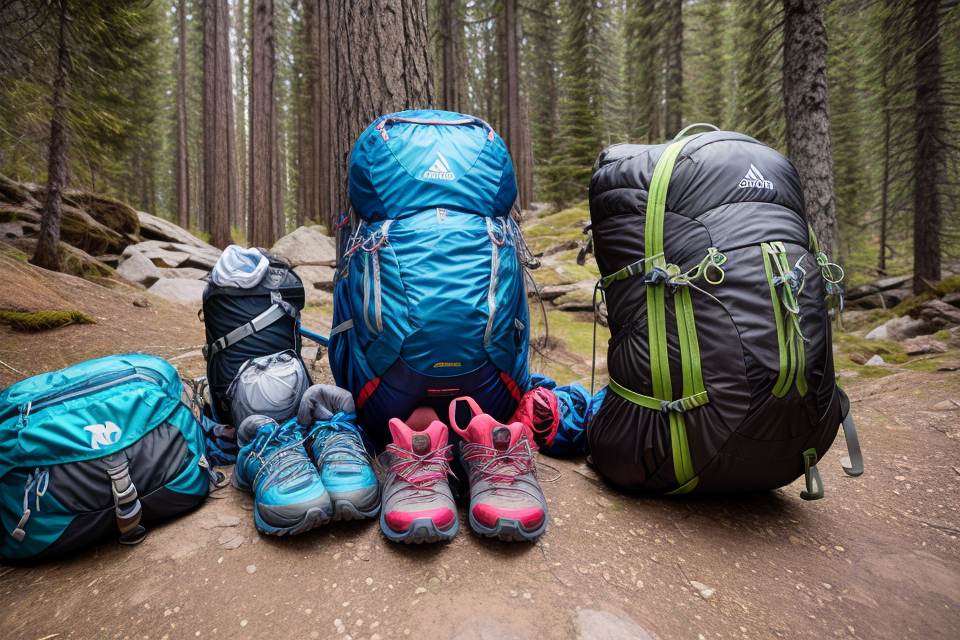Embarking on a journey to hike the Appalachian Trail (AT) is a dream come true for many outdoor enthusiasts. Spanning over 2,200 miles, the AT offers a thrilling adventure that takes you through 14 states, traversing diverse landscapes, including mountains, forests, and wild rivers. However, the question remains, is hiking the AT worth it? This comprehensive guide aims to provide you with all the information you need to make an informed decision about embarking on this epic journey. We will explore the challenges, rewards, and practicalities of hiking the AT, so you can plan your journey with confidence. Whether you’re a seasoned hiker or a novice, this guide will help you decide if the AT is the ultimate adventure for you. So, gear up and let’s dive in!
Planning Your Appalachian Trail Hike
Gear and Equipment
When it comes to hiking the Appalachian Trail, having the right gear and equipment is crucial for a safe and enjoyable journey. Here are some essential items to consider when planning your hike:
Essential Hiking Gear
- Tent or shelter: A lightweight and durable tent or shelter is necessary for shelter at night.
- Sleeping bag: A warm and comfortable sleeping bag that can withstand the weather conditions is essential.
- Backpack: A sturdy and comfortable backpack with enough storage space for your gear and supplies.
- Trekking poles: Trekking poles help with balance and stability, especially when crossing streams or navigating rough terrain.
- Headlamp or flashlight: A reliable source of light is necessary for navigating in the dark.
- First aid kit: A basic first aid kit is important for minor injuries and emergencies.
Clothing and Footwear
- Hiking boots or shoes: Sturdy and comfortable footwear is essential for long-distance hiking.
- Hiking socks: Moisture-wicking socks that fit well are important for preventing blisters and foot injuries.
- Quick-drying clothing: Bring lightweight and quick-drying clothing, including long-sleeved shirts, shorts, and pants.
- Extra layers: Bring extra layers of clothing for cold and wet weather conditions.
- Hat and sunglasses: A hat and sunglasses are important for protecting your face from the sun and rain.
Backpack and Hydration Systems
- Hydration system: A hydration system, such as a water bladder or water bottles, is necessary for staying hydrated during the hike.
- Filter or purification system: A filter or purification system is important for obtaining clean drinking water along the trail.
Navigation Tools
- Map and compass: A detailed map and compass are necessary for navigating the trail.
- GPS device: A GPS device or smartphone with GPS capabilities can be helpful for navigation and tracking progress.
- Guidebook or app: A guidebook or app with detailed information about the trail and surrounding areas can be helpful for planning and navigating.
Emergency Preparedness Kit
- Fire starter: A fire starter, such as a lighter or waterproof matches, is necessary for starting a fire for warmth and cooking.
- Signaling devices: Signaling devices, such as a whistle or flares, are important for attracting attention in emergency situations.
- Emergency shelter: A lightweight and compact emergency shelter, such as a bivy sack or tarp, is important for extreme weather conditions.
Overall, having the right gear and equipment is crucial for a safe and enjoyable hike on the Appalachian Trail. By planning ahead and investing in quality gear, hikers can prepare for any situation that may arise on the trail.
Physical and Mental Preparation
Hiking the Appalachian Trail is a challenging endeavor that requires both physical and mental preparation. In this section, we will discuss the various aspects of physical and mental preparation that are essential for a successful and enjoyable hike.
Physical Preparation
- Training Regimen: Before embarking on the Appalachian Trail, it is important to build up your physical endurance and strength. This can be achieved through a well-planned training regimen that includes both cardiovascular and strength training exercises.
- Cardiovascular Exercise: Cardiovascular exercise is crucial for building endurance and stamina. Activities such as running, cycling, and swimming can help to improve cardiovascular fitness.
- Strength Training: Strength training is essential for building the muscles needed for carrying a backpack and hiking for extended periods. Exercises such as squats, lunges, and deadlifts can help to build leg strength, while core exercises such as planks and sit-ups can help to build abdominal strength.
Mental Preparation
- Building Endurance and Stamina: In addition to physical preparation, mental preparation is also essential for hiking the Appalachian Trail. Building endurance and stamina can help to increase mental toughness and resilience.
- Setting Realistic Goals: Setting realistic goals can help to ensure a successful and enjoyable hike. Goals should be achievable and should take into account factors such as weather, terrain, and personal fitness level.
- Mental and Emotional Preparation: Mental and emotional preparation is also important for hiking the Appalachian Trail. This includes developing a positive mindset, managing stress and anxiety, and learning to cope with setbacks and challenges.
In conclusion, physical and mental preparation are both essential for a successful and enjoyable hike on the Appalachian Trail. By building up endurance and stamina, setting realistic goals, and developing a positive mindset, hikers can prepare themselves for the challenges and rewards of this incredible journey.
Logistics and Route Planning
Hiking the Appalachian Trail requires careful planning to ensure a safe and enjoyable experience. Logistics and route planning are crucial aspects of this process.
Determining the duration of your hike
The length of your hike will depend on your available time, physical fitness, and personal preferences. The average time to complete the entire trail is between five and seven months. However, shorter sections can be completed in a matter of days or weeks. It is essential to consider your goals and limitations when determining the duration of your hike.
Selecting a starting point and endpoint
The Appalachian Trail stretches from Georgia to Maine, and you can start and end your hike at various points along the way. Some popular starting points include Springer Mountain in Georgia and Mount Katahdin in Maine. The choice of starting point will affect the difficulty and length of your hike. It is important to research each section of the trail and choose a starting point that suits your skill level and interests.
Route options and variations
The Appalachian Trail offers various route options and variations, including side trails and alternative routes. The most popular route is the main trail, which runs from Georgia to Maine. However, there are several side trails and alternate routes that offer unique experiences, such as the White Mountain Loop in New Hampshire or the Franconia Ridge in New Hampshire. Researching these options can help you tailor your hike to your interests and skill level.
Obtaining necessary permits and permissions
Depending on the length and location of your hike, you may need to obtain permits and permissions. For example, some sections of the trail require a permit, and camping is only allowed in designated areas. It is important to research the regulations and requirements for the sections of the trail you plan to hike and obtain any necessary permits or permissions before you begin your journey.
The Joys and Challenges of Hiking the AT
Breathtaking Scenery and Natural Wonders
The Appalachian Trail (AT) is renowned for its stunning vistas, pristine wilderness areas, and rich biodiversity. Here’s a closer look at the breathtaking scenery and natural wonders that await you on this remarkable journey.
Spectacular Mountain Views
One of the most alluring aspects of the AT is the opportunity to witness the grandeur of the Appalachian Mountains. As you traverse the trail, you’ll encounter a variety of mountain ranges, each with its own unique character and beauty. From the rolling peaks of the Great Smoky Mountains to the rugged summits of the White Mountains, the AT offers an unparalleled panoramic experience.
Pristine Wilderness Areas
The AT meanders through some of the most pristine wilderness areas in the eastern United States. These protected lands provide a refuge for numerous plant and animal species, many of which are rare or endangered. As you hike, you’ll have the chance to explore remote forests, wild rivers, and secluded mountain valleys, immersing yourself in the unspoiled beauty of nature.
Rich Biodiversity and Ecosystems
The AT is home to a diverse array of plant and animal life, making it a haven for nature enthusiasts and biologists alike. From the vibrant wildflowers that blanket the trail in spring to the majestic trees that tower above it, the AT supports a vast array of ecosystems and species. You may encounter black bears, raccoons, and other wildlife, as well as a multitude of bird species, including the elusive bald eagle.
Rare Flora and Fauna
The AT is also a haven for rare and endangered plant and animal species. Some of these include the elusive golden-winged warbler, the Indiana bat, and the Carolina heelflower. By hiking the AT, you’ll have the opportunity to witness these unique and rare species in their natural habitats, contributing to a richer understanding and appreciation of the delicate balance of life in these ecosystems.
Connecting with Nature and Self
- Mindfulness and meditation
Hiking the Appalachian Trail (AT) provides an opportunity to cultivate mindfulness and meditation in the great outdoors. As you walk through the diverse landscapes, you’ll encounter a variety of sights and sounds that encourage you to stay present in the moment. This can help reduce stress and increase feelings of well-being.
- Disconnecting from technology
The AT is an ideal escape from the constant connectivity of modern life. By disconnecting from technology, you can fully immerse yourself in the natural world and appreciate the beauty of the trail without distractions. This disconnection can lead to a more profound connection with the environment and a greater appreciation for the simplicity of life on the trail.
- Developing a sense of appreciation for the environment
Hiking the AT fosters a deeper appreciation for the environment by providing an up-close look at the diverse ecosystems along the trail. You’ll witness the changing landscape, from the rugged peaks of Maine to the lush forests of Georgia, and gain a better understanding of the interconnectedness of all living things. This appreciation can translate into a lifelong commitment to environmental stewardship and conservation.
- Building resilience and self-reliance
The physical and mental challenges of hiking the AT can help build resilience and self-reliance. As you push yourself to overcome obstacles, both on and off the trail, you’ll develop a greater sense of self-confidence and self-awareness. This experience can be invaluable in other areas of life, as you’ll be better equipped to handle adversity and setbacks with a positive attitude.
Physical and Mental Toll
- The physical demands of hiking the Appalachian Trail (AT) cannot be overstated. With its steep and rugged terrain, hikers will need to be prepared for a rigorous physical challenge. The trail often ascends and descends thousands of feet in a single day, and the constant uphill and downhill hiking can take a toll on the body.
- The mental toll of hiking the AT is equally significant. Hikers will need to be mentally prepared for the isolation, monotony, and potential danger that come with spending months in the wilderness. The constant need to focus on navigation, weather patterns, and wildlife encounters can be mentally exhausting, and the isolation from civilization can lead to feelings of loneliness and depression.
- In addition to the physical and mental toll, hikers must also be prepared for the harsh weather conditions on the AT. Hikers may encounter extreme heat, cold, rain, and snow, and must be prepared to deal with these conditions in order to stay safe and healthy.
- Bears and other wildlife encounters are also a reality on the AT, and hikers must be prepared to deal with these encounters in a safe and responsible manner. Hikers must be aware of how to store food and other items to prevent attracting bears and other wildlife, and must also be prepared to deal with any potential encounters that may arise.
- Fatigue, injuries, and illnesses are also common on the AT, and hikers must be prepared to deal with these challenges as they arise. Hikers must be prepared to hike with a heavy pack, and must also be prepared to deal with any injuries or illnesses that may occur on the trail. It is important for hikers to have a plan in place for dealing with these challenges, and to have the necessary medical supplies and knowledge to handle any emergencies that may arise.
Thru-Hiking vs. Section Hiking
Thru-hiking and section hiking are two different approaches to hiking the Appalachian Trail (AT). Both offer unique experiences, but they vary in pace, experience, and commitment. To help you decide which approach is best for you, we’ll discuss the differences between thru-hiking and section hiking, as well as the benefits and drawbacks of each.
Differences in Pace and Experience
Thru-hiking is completing the entire AT in one continuous journey, usually taking between five to seven months. Section hiking involves completing the trail in multiple sections, taking a more leisurely approach and potentially spanning several years.
Thru-hiking is a more intense and physically demanding experience, requiring hikers to cover a greater distance each day. This pace often leads to a more immersive connection with the trail and a stronger sense of accomplishment upon completion. On the other hand, section hiking allows for a more relaxed pace, allowing hikers to explore the trail’s various attractions and communities more thoroughly.
Benefits and Drawbacks of Each Approach
Thru-Hiking
- Benefits: A more intense and immersive experience, a stronger sense of accomplishment, and a close-knit community of thru-hikers.
- Drawbacks: Higher physical and mental demands, limited time for exploration, and potential for burnout.
Section Hiking
- Benefits: A more leisurely pace, allowing for in-depth exploration of the trail and its attractions, and the ability to spread the experience over a longer period.
- Drawbacks: Lower sense of accomplishment, less intense connections with fellow hikers, and the possibility of losing momentum or motivation.
Tailoring Your Hike to Your Preferences and Abilities
Choosing between thru-hiking and section hiking depends on your personal preferences, abilities, and available time. If you’re looking for a more intense, immersive experience, thru-hiking may be the better choice. However, if you prefer a more relaxed pace and the ability to explore the trail’s many attractions, section hiking could be a better fit.
Ultimately, the key to a successful and enjoyable hiking experience on the AT is to tailor your journey to your individual needs and desires. By understanding the differences between thru-hiking and section hiking, you can make an informed decision about which approach is right for you.
Costs and Budgeting for Your Appalachian Trail Adventure
Financial Considerations
Hiking the Appalachian Trail requires careful planning and budgeting to ensure a successful and enjoyable experience. In this section, we will discuss the financial considerations that should be taken into account when planning your journey.
- Transportation and parking costs: The cost of transportation to and from the trailhead will depend on your starting point and mode of transportation. Additionally, you may need to pay for parking fees at trailheads or shuttle services to get to the starting point of your hike.
- Food and resupply expenses: Food is a significant expense while hiking the Appalachian Trail. You will need to budget for meals at restaurants, groceries, and snacks. Resupplying your food and equipment can also add up, especially if you are hiking for an extended period.
- Gear purchases and repairs: Gear is a significant investment when hiking the Appalachian Trail. You will need to budget for essential gear such as a backpack, tent, sleeping bag, and stove. You may also need to budget for repairs or replacements of gear during your hike.
- Accommodations and camping fees: If you choose to stay in accommodations along the trail, you will need to budget for the cost of lodging. Additionally, if you choose to camp, you will need to budget for camping fees at designated campsites or backcountry permits.
By considering these financial considerations, you can create a realistic budget for your Appalachian Trail adventure and ensure that you have a safe and enjoyable experience.
Frugal Tips and Tricks
- Meal planning and food storage
- Utilize cost-effective food options such as dehydrated meals, trail mix, and nuts to minimize expenses on meals.
- Store food in airtight containers to prevent spoilage and to keep them safe from rodents.
- Consider using a portable camping stove instead of relying on fire for cooking, which can save fuel and time.
- Water sources and filtration systems
- Plan your route to include sources of clean water such as streams and rivers, and use a water filter or purifier to ensure its safety for consumption.
- Carry at least one liter of water per person per day, and more in hot or dry conditions.
- Consider using a water bladder or hydration system to reduce the need for frequent refills.
- Hitchhiking and trail magic
- Hitchhiking is a common practice among thru-hikers to reduce the cost of transportation to and from trailheads.
- Trail magic refers to the act of kindness from strangers who offer food, shelter, or other forms of assistance to hikers.
- While not relying on these acts of kindness, they can be a nice surprise and help stretch your budget further.
- Shelter options and weather protection
- Choose shelter options that are both cost-effective and durable, such as a lightweight tarp or a simple tent.
- Consider using a bivy sack or a quilt as an alternative to a traditional sleeping bag, which can save weight and space.
- Pack appropriate clothing and gear to protect yourself from the elements, such as rain jackets, gloves, and hats.
Safety and Responsibility on the Appalachian Trail
Basic Safety Tips
When embarking on a journey along the Appalachian Trail, it is crucial to prioritize safety and responsibility. The following are some basic safety tips to ensure a safe and enjoyable experience:
- Bear safety and food storage: Bear safety is a critical aspect of hiking the Appalachian Trail. Bears are known to frequent the trail, and it is essential to store food and scented items properly to avoid attracting them. Hikers should store their food in bear-proof containers or at least 200 feet away from their campsite. It is also recommended to use a bear bag when camping in bear country.
- Hiking in groups and avoiding solo hikes: Hiking in groups is generally safer than hiking alone. Solo hikes can be dangerous, especially for inexperienced hikers. Hiking with a group provides a sense of security and support in case of an emergency. It is also helpful to have someone to share the experience with and to discuss the trail plans.
- Navigation and emergency preparedness: Proper navigation skills are essential for hiking the Appalachian Trail. Hikers should be familiar with using a map and compass and know how to navigate in various weather conditions. It is also important to be prepared for emergencies by carrying a first-aid kit, a fire starter, and a communication device. Hikers should also know how to signal for help and be aware of the closest trailhead in case of an emergency.
- Staying hydrated and avoiding heat exhaustion: Staying hydrated is crucial when hiking the Appalachian Trail. Hikers should drink at least one liter of water per hour and carry enough water to last for the entire hike. It is also important to avoid alcohol and caffeine, as they can lead to dehydration. Hikers should also be aware of the signs of heat exhaustion and take necessary precautions to prevent it, such as wearing loose-fitting clothing and taking frequent breaks in the shade.
Leave No Trace Principles
Hiking the Appalachian Trail (AT) is an incredible adventure, but it also comes with a responsibility to protect the environment and preserve its natural beauty for future generations. The Leave No Trace (LNT) principles are a set of guidelines designed to minimize the impact of human activities on the environment. As a hiker on the AT, it is essential to follow these principles to ensure the trail remains pristine and unspoiled.
The following are the seven LNT principles that hikers should adhere to while on the AT:
- Plan Ahead and Prepare: Before setting out on your hike, research the trail and its regulations, plan your route, and prepare adequately for the trip. This includes obtaining necessary permits, packing the right gear, and bringing enough food and water.
- Stay on the Trail: Hikers should stay on designated trails to avoid damaging fragile ecosystems, disturbing wildlife, and eroding the soil. It is also important to avoid trampling sensitive vegetation, such as rare plants and flowers.
- Respect Wildlife: Wildlife is an integral part of the AT’s ecosystem, and hikers should respect their habitat. This means not feeding animals, not disturbing them, and not leaving food or other items that may attract them. Hikers should also be cautious of bears and other wildlife and take necessary precautions to avoid conflicts.
- Dispose of Waste Properly: Hikers should pack out all their trash, including food wrappers, bottles, and cans. It is also important to dispose of human waste in designated areas to prevent the spread of diseases and to avoid contaminating water sources.
- Leave What You Find: Hikers should not collect or take any natural items, such as rocks, plants, or wildlife, from the trail. This includes taking photos or disturbing natural features, such as waterfalls or scenic vistas.
- Respect Other Hikers and Land Users: Hikers should be courteous and respectful to other hikers, campers, and land users. This includes yielding to uphill hikers, respecting their privacy, and not making excessive noise.
- Be a Good Ambassador: Hikers should promote the spirit of stewardship and encourage others to follow the LNT principles. This includes sharing their knowledge and experience with others and inspiring them to be responsible and respectful of the environment.
By following these principles, hikers can minimize their impact on the environment and ensure that the AT remains a pristine and unspoiled wilderness for generations to come.
Community and Support on the Trail
Hiking the Appalachian Trail can be a transformative experience, but it is not a solitary journey. You will encounter many fellow hikers, each with their own unique stories and experiences. As you trek through the trail, you may form strong bonds with these individuals, creating a supportive community that shares the same passion for the outdoors.
In addition to the personal connections you will make, there are several organizations dedicated to volunteer trail maintenance and preservation. These organizations provide an opportunity for hikers to give back to the trail, ensuring its continued existence for future generations.
By participating in these organizations, you will not only be contributing to the upkeep of the trail, but also forming connections with like-minded individuals who share your passion for the outdoors.
Moreover, as you journey through the trail, you will have the opportunity to share your experiences and advice with other hikers. This exchange of knowledge and stories can provide valuable insights and tips for navigating the trail, as well as offering a sense of camaraderie and support.
In conclusion, the community and support on the Appalachian Trail is an integral aspect of the hiking experience. Whether it be forming bonds with fellow hikers, contributing to trail maintenance, or sharing experiences and advice, the trail provides a unique opportunity to connect with others while exploring the beauty of nature.
FAQs
1. What is the Appalachian Trail?
The Appalachian Trail (AT) is a 2,200-mile (3,540 km) hiking trail that stretches from Springer Mountain in Georgia to Mount Katahdin in Maine. It passes through 14 states, including North Carolina, Tennessee, Virginia, West Virginia, Maryland, Pennsylvania, New Jersey, New York, Connecticut, Massachusetts, Vermont, New Hampshire, and Maine. The trail offers a challenging and rewarding experience for hikers of all levels.
2. How long does it take to hike the AT?
The time it takes to hike the entire Appalachian Trail varies depending on an individual’s hiking speed, experience, and personal goals. On average, it takes most hikers between 5 and 7 months to complete the entire trail. However, many hikers choose to section hike the trail, completing smaller sections at a time, which can take anywhere from a few days to a few weeks.
3. What are the highlights of the Appalachian Trail?
The Appalachian Trail offers a diverse range of landscapes, including mountains, forests, rivers, and waterfalls. Some of the most popular highlights include McAfee Knob in Virginia, Max Patch in North Carolina, Shenandoah National Park in Virginia, Great Smoky Mountains National Park in Tennessee and North Carolina, and Katahdin Woods and Waters National Monument in Maine.
4. What are the challenges of hiking the AT?
Hiking the Appalachian Trail presents several challenges, including physical exertion, weather conditions, and navigational difficulties. The trail often requires hikers to climb steep inclines, traverse rugged terrain, and cross streams and rivers. Hikers must also be prepared for sudden changes in weather, including rain, snow, and extreme heat. Finally, navigating the trail can be challenging, particularly in areas where the trail is not well-marked or where there are multiple trail intersections.
5. What are the requirements for thru-hiking the AT?
To thru-hike the Appalachian Trail, hikers must be physically fit, mentally prepared, and well-equipped with the necessary gear and supplies. There are no age or experience requirements, but hikers should be prepared to tackle long distances, challenging terrain, and varying weather conditions. Hikers must also obtain permits from the national parks and other protected areas along the trail.
6. What are the costs associated with hiking the AT?
The costs associated with hiking the Appalachian Trail vary depending on the hiker’s preferences and budget. Some costs to consider include gear and equipment, food and supplies, transportation to and from the trailhead, and accommodations and meals along the way. Hikers can save money by resupplying at grocery stores and towns along the trail, using trail angels for transportation and resupplies, and camping in free areas rather than paid campsites.
7. What is the best time of year to hike the AT?
The best time of year to hike the Appalachian Trail depends on personal preferences and weather conditions. Spring (April-May) and fall (September-October) are popular times to hike the trail due to mild weather and beautiful scenery. However, hikers should be prepared for potential weather changes, including snow and cold temperatures in the spring and fall. Summer (June-August) can be hot and humid, but also offers longer days for hiking. Winter (November-March) is a less crowded time to hike, but requires more gear and preparation for cold and potentially dangerous weather conditions.










